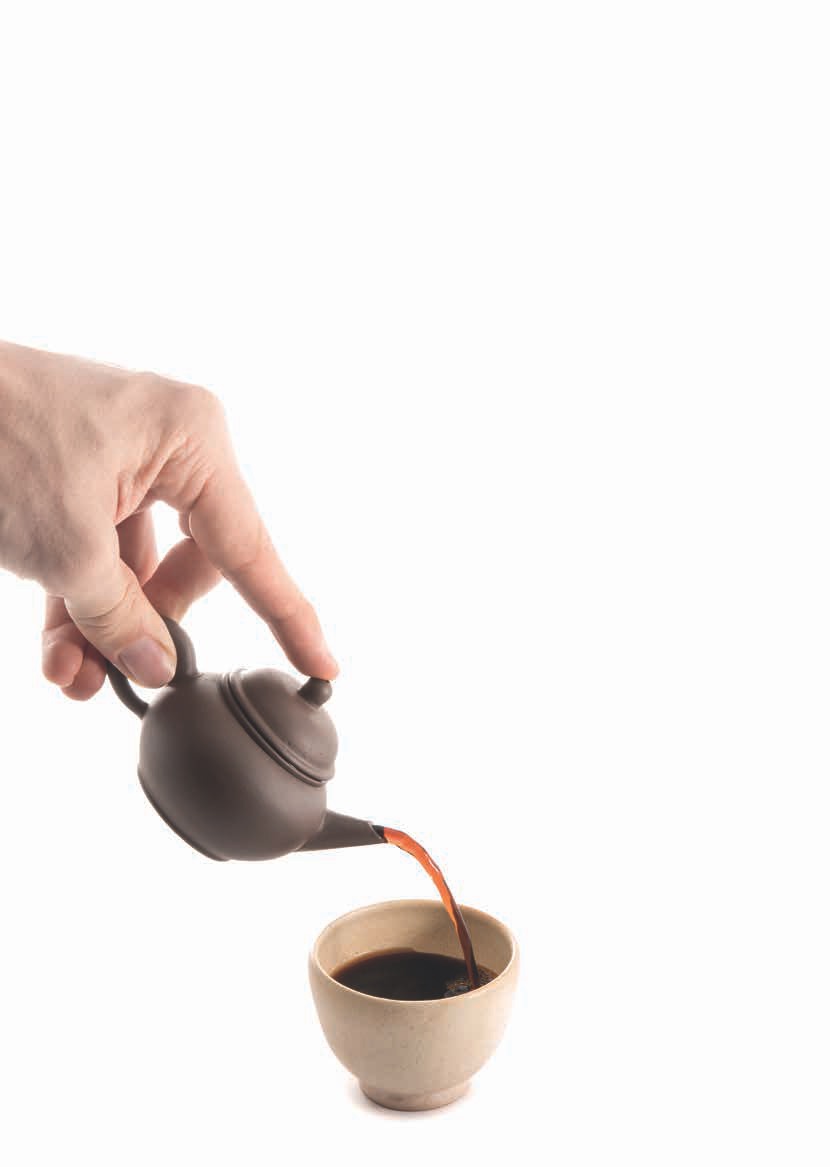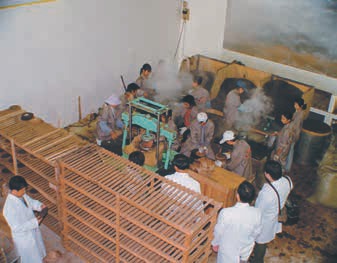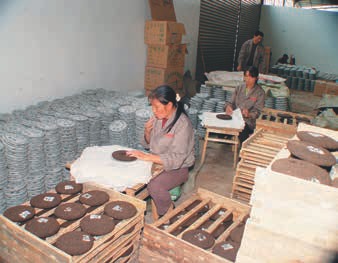
 |
|

Historically, Yunnan large-leaf tea would firstly be sun-dried to make maocha. After processing, the maocha would become what we call Yunnan puerh tea. If those puerh teas were not being consumed immediately but were being stored for years, we would then call them aged teas. Nowadays, tea producers often further process maocha by the procedure of wo dui (渥堆), and we would also classify those teas as puerh. If the tea leaves were sold as they were after being processed, they would be called loose-leaf puerh. If the tea leaves were further processed and compressed into the form of a cake, a bowl or a brick, we would call them compressed puerh tea. Different kinds of Yunnan compressed teas have different names in different places. However, I believe what really matters is that you understand the classification of those teas.
Yunnan puerh tea is commonly classified into sheng tea - subcategorized as "dry-stored" and "wet/ traditionally-stored" sheng puerh - and the second main category, shou tea. Some people nowadays prefer to classify puerh tea by the location in which the teas were stored: Yunnan, Malaysia, Guangzhou, Hong Kong or Taiwan, for example.
Before 1985, the production and supply of all tea leaves in the Mainland was organized by the Tea Corporation of China. There were production schedules or sales targets for every tea planter, tea producer and tea seller. Each and every process you can imagine about tea (including planting, processing, producing and selling) in Mainland China was implemented based on the annual production schedule set by the Tea Corporation of China.
During this period, Yunnan compressed puerh tea was commonly classified into three categories: border-sale tea, domestic market tea and export tea. Border-sale teas were sold to the western border areas of China, including Tibet, Qinghai, Gansu, Xinjiang, etc.; domestic market teas were sold to Sichuan, Hunan, Guangdong, etc.; while export teas were mainly exported to Europe. Most of the border-sale teas and domestic market teas were sheng puerh, while most of the teas exported to Europe were shou puerh.
Tea retailers in Guangdong Province found that sheng puerh must be aged for a long period of time before they could be sold in the market. In response to this problem, the Yunnan Province Import and Export Corporation arranged for the staff members of the three state-owned tea producers in Yunnan, namely the Kunming Tea Factory, the Xiaguan Tea Factory and the Menghai Tea Factory, to learn the production method of shou tea in Guangdong.
It was hoped that by learning the wo dui technique from Guangdong tea producers, the time required to age sheng puerh could be shortened. However, all three of the tea producers failed in their first attempt, which brought them back to Guangdong again in 1971. This time, the Xiaguan Tea Factory succeeded in producing shou puerh tea. However, as this factory was focusing on producing border-sale, large-leaf sheng teas, it decided not to start the production of shou puerh immediately. The Kunming Tea Factory was the first runner-up to succeed in the production of shou teas, and it became the first Yunnan tea factory to produce and export shou tea bricks. That's the reason why the public wrongly assumed the Kunming Tea Factory was the first tea factory to learn the craft of shou tea production.
We all know that the Menghai Tea Factory, the loser in the above race, produces the largest variety of shou puerh teas with the best quality. If I were to guess the reasons behind this, I would say that the advantage of the Menghai Tea Factory lies in its geographic location. Xishuangbanna, where the Menghai Tea Factory is located, has a sub-tropical climate, and both the temperature and moisture level in the region are suitable for the wo dui process to take place. It is agreed that the shou puerh teas produced by the Menghai Tea Factory are the best, and both the flavor and aftertaste of these shou puerh are beloved by tea lovers, so much so that it has come to be known as the "classic" shou flavor that tea lovers seek out in the shou puerh they purchase.
Even after the tea industry in Mainland China had undergone reformation and was opened up in 1985, shou puerh tea was still being tightly controlled by the government. Without the permission of the Yunnan government, tea producers (including stated-owned producers) were not allowed to process and sell shou puerh teas. This was done to ensure that the shou puerh teas exported to Europe were stable in quality.
In the late 1980s, the government started to loosen its grip on the shou tea industry in Yunnan. Nowadays, most tea factories in Yunnan are producing shou puerh teas. However, due to the lack of techniques in the wo dui process, combined with lack of proper control in the quality of raw materials, temperature level and moisture level, most of those factories are unable to produce shou teas that are stable in quality. The shou puerh teas produced by those tea factories are often under-fermented, over-fermented or unevenly-fermented.
I have often heard our fellow tea lovers say that some puerh teas were "mixed." For example, they would say a puerh was 30% sheng mixed with 70% shou, while the other one was 20% sheng mixed with 80% shou. This was not the case, at least not for the teas produced in Yunnan before 2000. The truth is that the technicians responsible for the fermentation process of shou teas would sometimes decide to dry the teas earlier, stopping the fermentation sooner, based on the types of leaves they were using and what their goals were in creating a shou puerh. Some small tea factories in Yunnan unwisely believed there was some truth in the myth, and they started producing compressed mixed teas in the early 2000s. In fact, the production method of shou puerh was a secret between the tea producers in Yunnan, and only a handful of technicians who were responsible for the fermentation process would know the tricks of the trade. In recent years, the representatives of tea companies from other areas have often requested to visit the tea producers in Yunnan, and some of them naïvely thought that they could master the craft in one visit. I believe we should all be concerned about the consequences of letting such tea producers make shou puerh themselves. The piling process involve the fermentation of bacteria and other microbes, so there are obviously health factors to consider when producing shou puerh tea, especially on a large scale.
I am really grateful that the Changtai Tea Factory in Xishuangbanna, Yunnan, agreed to let me take photos to record the production process of shou puerh teas so that our fellow readers can learn more about Yunnan shou puerh tea. The Changtai Tea Factory was established in 1999. In the beginning, the business focused on producing wild arbor puerh. As per the request of customers, the factory started producing shou teas, and shou puerh has become one of the hot-selling products for the factory. In the past, the fermentation plant of the Changtai Tea Factory was located in Jinggu County, Simao Prefecture. Owing to the constantly increasing demand for their products, the business has built a larger fermentation plant near the Dadu River. It is estimated that the annual production capacity of the company is 1,000 tons of loose-leaf shou puerh.
Before fermenting the puerh teas, the factory needs to prepare the maocha. The maocha can be wild arbor puerh, planted puerh or a mix of the two, depending on the requirements of customers. The tea leaves used are generally thick and old, unless otherwise requested by the customer. The shou puerh produced can be classified as spring harvest, summer harvest and autumn harvest (also commonly called "gu hua cha, 穀花茶"), according to the season in which the tea leaves are collected. For each harvest, six to fourteen tons of tea leaves are fermented.
Before fermenting the maocha, the fermentation plant must be cleaned thoroughly. The size of the fermentation area depends on the amount of maocha being processed, while the thickness of the maocha should not exceed two feet, regardless of the amount of tea being fermented. Before the fermentation process begins, the water content of the maocha is generally less than 10%. During the process, water is added constantly to the tea, until the water content level reaches 25%. Throughout this time, the technicians keep turning the tea until its condition meets the requirement of the customers. After that, the tea is flattened and dried. Generally speaking, it takes three months to complete the fermentation,drying and compression process.

So, how can you determine how well a shou puerh is fermented?


